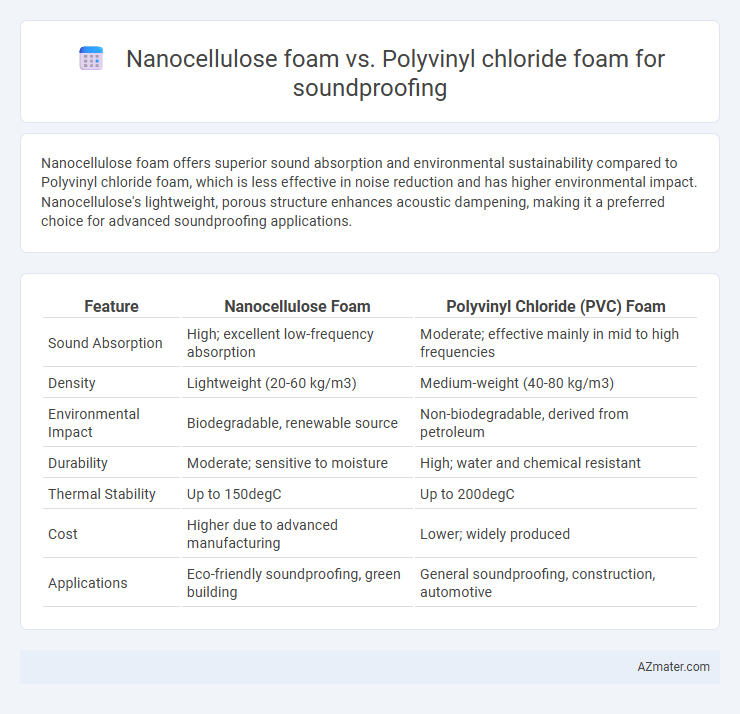Nanocellulose foam offers superior sound absorption and environmental sustainability compared to Polyvinyl chloride foam, which is less effective in noise reduction and has higher environmental impact. Nanocellulose's lightweight, porous structure enhances acoustic dampening, making it a preferred choice for advanced soundproofing applications.
Table of Comparison
| Feature | Nanocellulose Foam | Polyvinyl Chloride (PVC) Foam |
|---|---|---|
| Sound Absorption | High; excellent low-frequency absorption | Moderate; effective mainly in mid to high frequencies |
| Density | Lightweight (20-60 kg/m3) | Medium-weight (40-80 kg/m3) |
| Environmental Impact | Biodegradable, renewable source | Non-biodegradable, derived from petroleum |
| Durability | Moderate; sensitive to moisture | High; water and chemical resistant |
| Thermal Stability | Up to 150degC | Up to 200degC |
| Cost | Higher due to advanced manufacturing | Lower; widely produced |
| Applications | Eco-friendly soundproofing, green building | General soundproofing, construction, automotive |
Introduction to Soundproofing Materials
Nanocellulose foam and Polyvinyl chloride (PVC) foam are prominent soundproofing materials with distinct acoustic properties and environmental impacts. Nanocellulose foam, derived from natural cellulose fibers, offers superior sound absorption due to its porous structure and lightweight nature, making it effective for high-frequency noise reduction. In contrast, PVC foam is a synthetic polymer known for its durability and moisture resistance, providing robust sound insulation primarily in industrial and construction applications.
Overview of Nanocellulose Foam
Nanocellulose foam offers exceptional sound absorption properties due to its high porosity and lightweight structure composed of cellulose nanofibers. Compared to polyvinyl chloride (PVC) foam, nanocellulose foam is biodegradable, renewable, and non-toxic, making it an eco-friendly alternative for acoustic insulation. Its tunable pore size and surface chemistry enhance sound damping efficiency, positioning it as a sustainable option in soundproofing applications.
Key Properties of Polyvinyl Chloride (PVC) Foam
Polyvinyl chloride (PVC) foam is widely recognized for its excellent acoustic insulation properties due to its closed-cell structure, which effectively reduces sound transmission and dampens vibrations. Its high density and rigidity contribute to superior impact resistance and durability compared to lightweight alternatives like nanocellulose foam. PVC foam also offers enhanced moisture resistance and fire retardancy, making it a versatile material for soundproofing applications in construction and automotive industries.
Acoustic Performance: Nanocellulose vs PVC Foam
Nanocellulose foam exhibits superior acoustic absorption due to its high porosity and nanoscale fibril network, enabling efficient sound energy dissipation across a broad frequency range compared to polyvinyl chloride (PVC) foam. PVC foam, though lightweight and cost-effective, tends to have a more uniform and less porous structure that limits its capacity to attenuate mid-to-high frequency noise effectively. Studies show nanocellulose foam offers enhanced soundproofing by reducing sound transmission loss and improving noise reduction coefficients, making it a promising material for advanced acoustic insulation applications.
Environmental Impact and Sustainability
Nanocellulose foam outperforms polyvinyl chloride (PVC) foam in environmental impact and sustainability due to its biodegradable nature and renewable cellulose source derived from plants or wood fibers. PVC foam relies on non-renewable fossil fuels for production and generates harmful dioxins during manufacturing and disposal, contributing significantly to pollution and landfill burden. The low carbon footprint, recyclability, and non-toxic degradation of nanocellulose foam make it a superior eco-friendly alternative for sustainable soundproofing solutions.
Mechanical Strength and Durability Comparison
Nanocellulose foam demonstrates superior mechanical strength due to its high aspect ratio and robust hydrogen bonding between cellulose fibers, resulting in enhanced load-bearing capacity and resistance to deformation compared to polyvinyl chloride (PVC) foam. PVC foam, while offering moderate mechanical strength, tends to exhibit lower durability under prolonged mechanical stress and environmental exposure, with potential degradation from UV radiation and plasticizer loss. The biodegradability and renewable nature of nanocellulose foam further contribute to its long-term durability and sustainable performance in soundproofing applications.
Thermal Insulation Capabilities
Nanocellulose foam exhibits superior thermal insulation capabilities compared to polyvinyl chloride (PVC) foam due to its highly porous nanostructure and low thermal conductivity, typically around 0.03 W/m*K. PVC foam, with thermal conductivity values ranging from 0.04 to 0.06 W/m*K, provides adequate but less efficient insulation in soundproofing applications. The biodegradability and renewable nature of nanocellulose foam also enhance its appeal as an environmentally friendly alternative with enhanced thermal management properties.
Fire Resistance and Safety Considerations
Nanocellulose foam exhibits superior fire resistance compared to polyvinyl chloride (PVC) foam, as it is inherently biodegradable and has a higher ignition temperature, reducing the risk of toxic gas emissions during combustion. PVC foam often contains harmful additives such as chlorine, which release toxic fumes like hydrogen chloride when burned, posing significant safety hazards in soundproofing applications. These fire safety considerations make nanocellulose foam a more environmentally friendly and safer choice for sustainable soundproofing solutions.
Cost Analysis and Market Availability
Nanocellulose foam offers a sustainable and biodegradable alternative to Polyvinyl chloride (PVC) foam, with initial manufacturing costs currently higher due to specialized production processes and limited large-scale availability. PVC foam remains widely available in the market, benefiting from established supply chains and economies of scale, resulting in lower upfront costs for soundproofing applications. Market trends indicate increasing interest in nanocellulose foam as production technologies advance, potentially narrowing the cost gap and expanding its commercial availability in the near future.
Future Trends in Soundproofing Materials
Nanocellulose foam offers a sustainable and biodegradable alternative to traditional polyvinyl chloride (PVC) foam, showing increasing potential in soundproofing applications due to its superior acoustic insulation, lightweight nature, and renewable sourcing. Future trends indicate a shift towards eco-friendly materials like nanocellulose that provide high noise absorption while reducing environmental impact, supported by advancing nanotechnology and material science enhancing their durability and performance. Innovations in combining nanocellulose with other bio-based composites are expected to further improve sound dampening efficiency, positioning it as a key player in the next generation of soundproofing materials.

Infographic: Nanocellulose foam vs Polyvinyl chloride foam for Soundproofing
 azmater.com
azmater.com